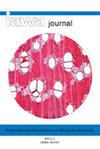塞尔维亚分裂维管柱体的个体发生:一种新的维管结构在皂荚科的兴起
IF 3.5
3区 农林科学
Q2 FORESTRY
引用次数: 3
摘要
皂荚科藤本植物的茎部形成层变异多样性显著。该家族独有的形成层变异之一是分裂的维管圆柱体,它出现在Serjania属的八个物种中。形成层变异的特征是在一个大髓周围有5个周围的维管柱。本研究结合传统植物解剖技术和高分辨率x射线显微计算机断层扫描技术,对三种维管柱分裂的植物茎的结构和发育进行了比较分析。我们的观察表明,茎发育的初始阶段与文献中描述的相似,然而,在发育的后期,所有物种都出现了一个中央维管柱。这些茎的个体发育有三个主要过程:(i)从周围维管柱上剥离维管组织;(ii)通过髓细胞的再分化形成新的形成层弧;(iii)外周维管柱的维管形成层内部的形成层细胞的招募,在髓所在的地方形成一个新的中央维管柱,由五个初始的外周圆柱体包围。作为一个较远的发育阶段,一些老茎也会形成新生物,并在不同维管柱之间形成连接。虽然我们的研究结果支持先前关于分裂维管柱的描述,但这是第一次研究表明在这种形成层变异中中央维管柱的形成。我们的观察结果进一步证实,塞尔维亚是所有维管植物中形成层变异形式最高和最复杂的谱系。本文章由计算机程序翻译,如有差异,请以英文原文为准。
Ontogeny of divided vascular cylinders in Serjania: the rise of a novel vascular architecture in Sapindaceae
Sapindaceae lianas are remarkable for the diversity of cambial variants found in their stems. One of the family’s exclusive cambial variant is the divided vascular cylinder, which occurs in eight species of the genus Serjania. This cambial variant is marked by 5 peripheral vascular cylinders around a large pith. We performed a comparative developmental analysis, integrating traditional plant anatomy techniques with high-resolution X-ray micro-computed tomography to investigate the structure and development of the stems of three species with divided vascular cylinder. Our observations showed that the initial stages of stem development were similar to those described in the literature, however, on later developmental stages a central vascular cylinder appears in all species. The ontogeny of these stems are marked by three main processes: (i) dissection of vascular tissue from the peripheral vascular cylinders; (ii) development of new cambial arcs through the redifferentiation of pith cells; and (iii) recruitment of cambial cells from the inner portions of the vascular cambium of the peripheral vascular cylinders, forming a novel central vascular cylinder where the pith was, surrounded by five initial peripheral cylinders. As an ulterior developmental stage, some older stems also develop neoformations and connections between the different vascular cylinders. While our findings support previous descriptions of divided vascular cylinders, this is the first study illustrating the formation of the central vascular cylinder in this cambial variant. Our observations further corroborate that Serjania is the lineage with the highest and some of the most complex forms of cambial variants among all vascular plants.
求助全文
通过发布文献求助,成功后即可免费获取论文全文。
去求助
来源期刊

IAWA Journal
农林科学-林学
CiteScore
3.40
自引率
15.80%
发文量
26
审稿时长
>36 weeks
期刊介绍:
The IAWA Journal is the only international periodical fully devoted to structure, function, identification and utilisation of wood and bark in trees, shrubs, lianas, palms, bamboo and herbs. Many papers are of a multidisciplinary nature, linking
 求助内容:
求助内容: 应助结果提醒方式:
应助结果提醒方式:


